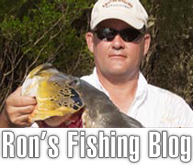First Years Bass Fishing at Lake El Salto
 [Editor: this article first appeared on www.ronsfishingblog and may only be used by permission of Ron Speed]
[Editor: this article first appeared on www.ronsfishingblog and may only be used by permission of Ron Speed]
Today I am going to talk about the early days of bass fishing at Lake El Salto in Mexico. Last week’s blog was about El Salto and the reason I am talking about it again is that Salto and Lake Fork in Texas have become the two most famous lakes in bass fishing history.
We opened the fishing camp on the water in November of 1990. The fishing was good but not great as far as big fish caught. Our clients caught lots of numbers, just like at all new Mexican lakes, but most were in the 2 to 4 lb range with many smaller than 2 lbs. Every so often a client would catch a 5 or 6 pound fish, but there weren’t many that size.
We continued to operate on this lake until clients became tired of catching so many small bass and the fish became very skinny. They looked like they were starving to death. When the lake was new in that first year there were plenty of threadfin shad and tilapia for the bass to eat. The netters had caught many tons of the tilapia since in those years they didn’t have a conservation program in effect like they do now. Also, the lake had so many black bass that the tilapia and the shad were all eaten up in a couple of years.
I had seen this happen only once in my life and that was in Cuba’s Lake Hanabanilla. The Cuban fishing department had asked me to fish the lake and tell them why there were no middle size (2 lb to 5 lb) bass in the lake. I took Jimmy Olive–a great friend from Port Arthur, Texas–with me to this lake. In 3 days of fishing we caught over 100 bass a day in shallow water with none weighing over a pound. We moved out to deep water and caught bass up to 10 lbs. Those bass were not really fat and in good condition and we too found no middle size bass. I wrote my report to the Cubans advising them to stock some forage fish like shad or bluegill if they wanted to produce more middle-size fish. The bass in Hanabanilla had turned to cannibals and were feeding off of smaller bass since there was nothing else for them to eat. Consequently there were no middle-size bass.
Now here we are at Lake El Salto 13 years later facing a similar problem. We closed down our camp for 2 years and I began looking for a solution. I called the head of the Fishing department in Texas and told him what the situation was at Salto. He advised me to do the same thing that I had advised the Cubans to do 13 years earlier. Since I had never tried to transport live shad, I had him tell me exactly how to do it. He also sent me a booklet with all the details.
The camp manager at that time was Segis Benetez, and Segis knew where there was a lagoon near the ocean that had lots of threadfin shad. I explained to Segis on how to catch and transport shad so they would live. I had learned that you must catch the shad at night in a seine when it is cool. You cannot touch the shad with your hands, your transport container must be round like a barrel, and you must fill the barrel with water where the shad live so as to have exactly the same water temperature.
Segis and Beto, one of the local boys who worked at the camp, spent 2 months catching and hauling shad to the lake. The next season we saw thousands of shad on top of the water in Lake El Salto and in a matter of months we were not catching any skinny bass. The bass got really fat, but did not seem to grow any bigger until we began stocking the lake with Florida bass…another story for another time!!!!!!!
ENJOY YOUR FISHING AND WEAR THAT LIFEJACKET!!!

